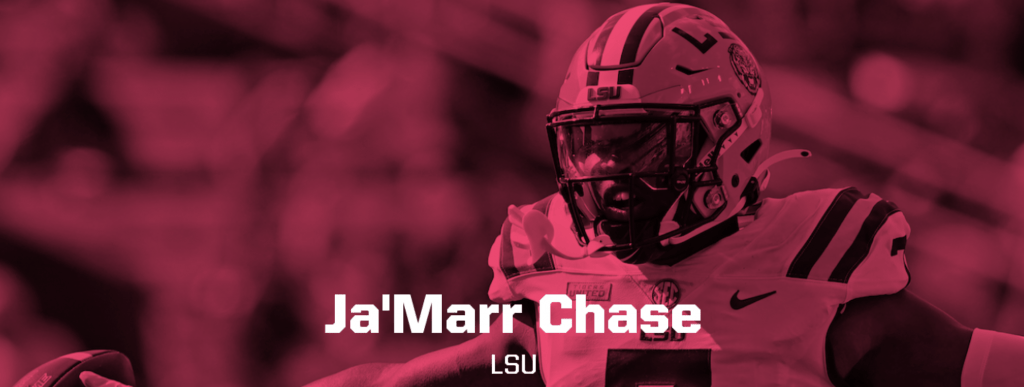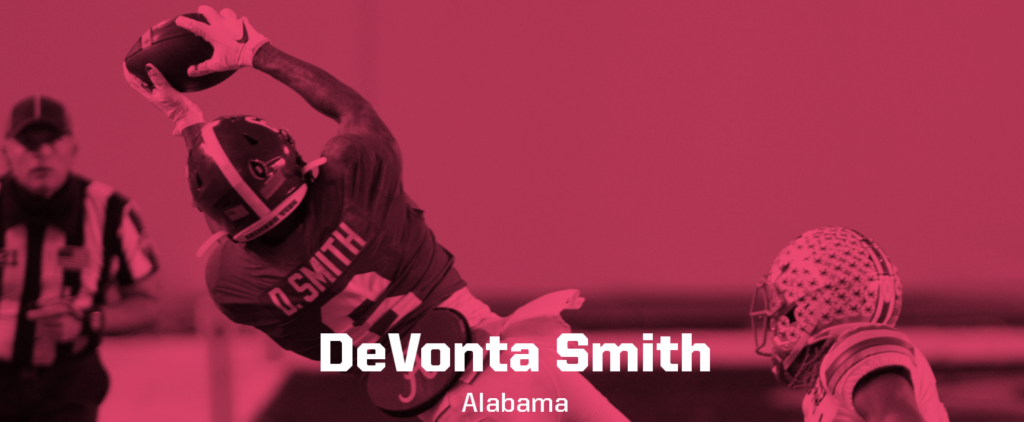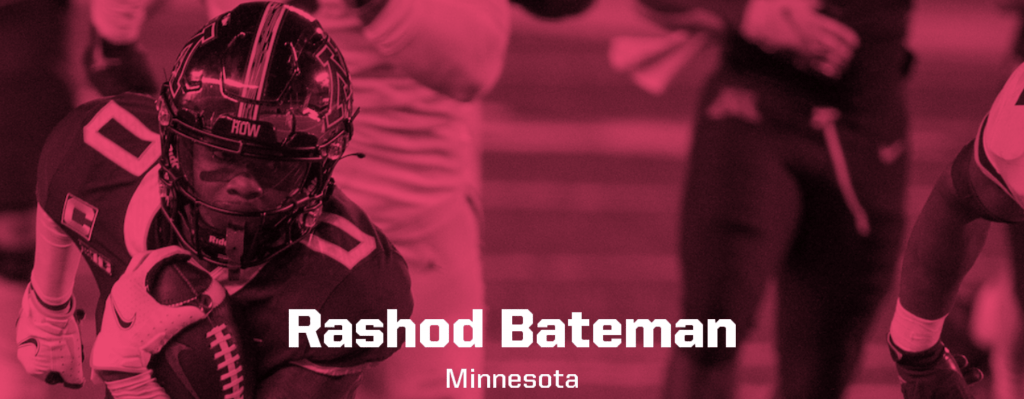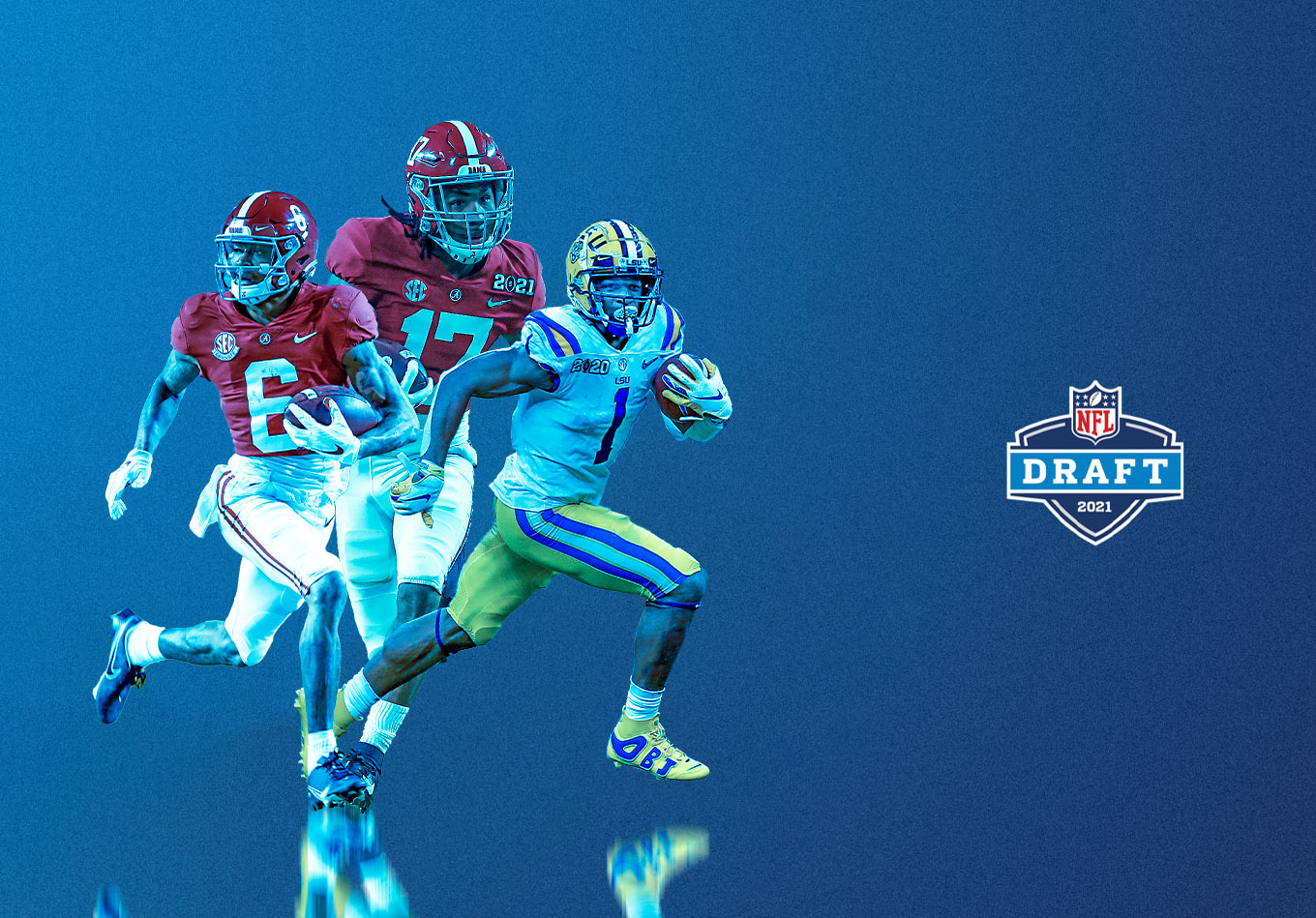We’re less than a week away from a highly anticipated NFL draft. Leading up to the event, we’re taking a look at the most interesting players at each position. Today, it’s the wideouts that have our attention.
The 2020 NFL draft delivered one of the best wide receiver classes of the modern era, headlined by Justin Jefferson producing a historic rookie season for the Minnesota Vikings. Unfortunately for NFL defenders, the 2021 crop may well be even better.
Jefferson, who went 22nd in the draft last year as the fifth receiver selected, set a league record for the most receiving yards by a rookie as he racked up an incredible 1,400 in 2020.
Six receivers went in the first 32 picks last year, with CeeDee Lamb, Brandon Aiyuk and Jerry Jeudy all impressing in their debut seasons.
That number might not be matched this year, but it looks likely there will be at least four receivers taken on Day 1. Ja’Marr Chase, DeVonta Smith, Jaylen Waddle and Rashod Bateman all possess skill sets that should mean they too can take the league by storm as Jefferson did so emphatically last season.
Beyond that quartet, there is a deep crop of likely Day 2 picks who can make an immediate impact for teams looking to bolster their pass-catching options.
Franchises eyeing an infusion of talent in the slot won’t be short of options and as the league tilts ever further towards pass-heavy offenses, it is an excellent year to be in need of a receiver regardless of where they line up.
Here we take an in-depth look at the consensus top four as well as some of the best of rest in another class of wideouts that has the potential to transform offenses across the league.

Widely regarded as the top receiver in the class, Chase earned that moniker despite not displaying the ability to separate from coverage at an elite level.
In 2019, Chase was open on 61.8% of his targets, well below the average of 69.7% among Power Five receivers with at least 20 targets.
Yet he put up 127.1 yards per game – second in the FBS behind Arkansas State’s Omar Bayless (127.2) – and was second in yards per reception among receivers with at least 40 catches with an average of 21.2 that trailed only Lamb (21.4).
His pass rating when targeted of 233.0 was second in the same group, with Smith (238.6) the sole man ahead of him.
Chase excelled in spite of a lack of separation because of two factors: his hand usage and his proficiency at the catch point. To watch Chase is perhaps as close as you will come to watching a pass rusher play receiver. He excels at working off physical press coverage and shows the willingness to aggressively handfight with defenders throughout the route to gain an advantage.
At the catch point, the explosion in his lower body that helped him record a 41-inch vertical jump at his pro day comes to the fore, with Chase consistently succeeding in elevating over the heads of defenders to come down with the ball in contested-catch situations.
His success in those areas helped Chase finish sixth among Power Five receivers with a minimum of 50 targets with a big-play percentage of 45.6, far outranking that of his former Tigers teammate Jefferson (38.8).
After a year away from the game following his 2020 opt-out, teams picking in the top 10 must decide if Chase’s skill set can translate to the NFL as well as Jefferson’s did. The majority of the numbers from his critical role in LSU’s march to the national championship present a compelling case.

Smith could have declared for the draft last year and been considered the top Alabama receiver in a draft that saw Crimson Tide stars Henry Ruggs III and Jeudy go in the first round after a stunning 2019 in which he outperformed both.
His decision to return was emphatically vindicated, though, when Smith became the first receiver to win the Heisman Trophy since Desmond Howard in 1991.
Doubts over Smith’s 166-pound frame will persist, yet there was nothing during his career at Alabama to suggest his lack of bulk will be something that prevents him from succeeding at the next level.
Adept at creating separation with his route-running, Smith was open on 85.8% of his targets – seventh among all Power Five receivers with at least 50 targets – while his burn percentage of 76.4 trailed only Ohio State duo Garrett Wilson and Chris Olave.
Smith also finished second in the FBS with 142.8 receiving yards per game. And rather than allowing himself to be hindered by his slender frame at the catch point, Smith relied on his leaping ability and body control to haul in one spectacular grab after another. His catch percentage of 79.6 was eighth in the FBS among receivers with a minimum of 50 targets.
Deceptively quick and elusive with the ball in his hands, Smith’s average yards after catch per reception of 8.33 ranked sixth among wideouts with 40 or more receptions.
In short, there is not a facet of the game in which Smith did not excel. Perhaps his lean frame, and the doubts over whether he can succeed against press coverage that come with it, will put off some top-10 teams, but there is little evidence to suggest that Smith cannot live up to the weight of expectations that come with being drafted in the first round.

The same durability concerns surrounding Smith could be applied to Waddle after his final season with Alabama was curtailed by an ankle injury, though he made an ill-advised return for their national championship game win over Ohio State.
However, any lingering doubts over his health will likely be put to one side with Waddle firmly established as the premier deep threat in the draft.
Blessed with game-changing speed and a remarkable talent for elevating at the catch point for a receiver of his 5-foot-10, 182-pound frame, Waddle was sensational in six games in 2020 for the Crimson Tide.
He averaged 21.1 yards per reception, a number only bettered by Western Michigan’s D’Wayne Eskridge (23.3) among those with 25 catches in the FBS, and he frequently gained substantial separation from defenders to make huge plays downfield.
Waddle was open on an astonishing 90.6% of his targets in 2020; the average was 72.8 among receivers with a minimum of 20 targets.
That number can partially be attributed to the success of Steve Sarkisian’s scheme last season. However, a burn yards per target average of 19.96 – bettered by just two receivers who met that 20-target threshold – speaks to his ability to defeat coverage with a frightening combination of agility and acceleration that helped him produce 10.3 YAC per reception (13th in the FBS for wideouts with a minimum of 25 catches).
In addition to his explosiveness, Waddle brings reliability that is not always a fixture of deep threats in the NFL. He dropped only one pass on 32 targets last year, catching 87.5% of balls thrown his way (third in the FBS among receivers with at least 30 targets).
Waddle finished his final season in Tuscaloosa with a catch rating of 0.966, further illustrating his status as a receiver who excelled at hauling in catchable passes and consistently ensured those receptions ended in big plays. Nothing scares NFL defenses more than speed and, regardless of where Waddle lands, corners across the league can consider themselves on notice.

While Chase, Smith and Waddle have garnered the vast majority of the attention, Bateman has an extremely credible claim for being the most well-rounded receiver in the entire class.
His case was not helped by a 2020 season in which he only played five games due to a battle with coronavirus, but his 2019 campaign was one illustrative of a prospect with all the tools to blossom into a No. 1 wideout at the highest level.
A talented downfield weapon who was open on 70.8% of his targets in 2019 with an average depth of target of 16.2 yards, Bateman does an excellent job of engineering separation with his route-running.
His burn yards per target average of 16.15 was sixth among all Power Five receivers with at least 50 targets two seasons ago and only Ruggs and Olave in the same group had a higher big-play percentage than Bateman’s 50.4.
Bateman can use his 6-foot, 190-pound frame to dominate at the catch point, while his abilities after the catch have been severely underrated. Indeed, his missed/broken tackle per touch rate of 0.300 was superior to that of Smith (0.299) in the same year, though Chase (0.353) and Waddle (0.441) each outperformed him in that regard.
He could go well outside the top 10, but should Bateman put everything together in the pros with the same consistency as he did in college in 2019, he could prove to be the best of an ultra-talented bunch.
Best of the Rest
For as exciting of a prospect as Bateman is, many believe Terrace Marshall Jr. is even better.
He was the forgotten man in that juggernaut LSU offense of 2019 and impressed last year when thrust into the lead receiver role following the exits of Joe Burrow, Chase, Justin Jefferson and play-caller Joe Brady.
Boasting an intriguing blend of size and speed, Marshall ranked 14th in the FBS in 2020 with 104.4 receiving yards per game. Only two receivers – Smith and Jaelon Darden – caught more than Marshall’s 23 touchdowns over the last two seasons.
North Carolina’s Dyami Brown is of a similar physical profile to Marshall but used it in a very different way, developing into one of college football’s premier deep threats. With an air yards per target average of 17.6 last season, Brown led FBS receivers with a minimum of 40 catches as he averaged 20.0 yards per reception.
He was open on 75.6% of his targets despite having the fourth-highest average depth of target (18.0 yards) among Power Five receivers with at least 20 targets. He also ranked seventh with 17.30 average burn yards per target.
While Brown does the bulk of his damage getting downfield before making the catch, teams eyeing receivers who can pick up significant yardage after the reception will have taken a strong look at Florida star Kadarius Toney.
Toney enjoyed a breakout year in 2020, using the elasticity in his legs to rack up 6.93 yards after catch per reception – 20th among receivers with a minimum of 40 receptions. He had a missed/broken tackle per touch rate of 0.360 that was bettered by just four wideouts among Power Five receivers with a minimum of 50 targets.
And though there is concern about Toney’s status as a one-year wonder who often ran undisciplined routes, his hands have proven extremely reliable. His catch percentage of 83.3 ranked fourth among FBS receivers targeted at least 50 times.
Elijah Moore can’t quite match Toney for YAC (6.02 per reception in 2020) but he was the picture of reliability for Ole Miss last season. He led the FBS in receiving yards per game with 149.1 while catching 84.3% of his targets (third in FBS among those with 50 targets).
Ultra-dependable at the catch point, Moore demonstrates extremely strong hands, excellent ball-tracking ability and the body control to adjust to inaccurate passes. His catch rating, which measures how well a receiver successfully brings in throws that are considered catchable, of 0.989 was second in the Power Five among those with at least 50 targets in 2020.
Beating defenders consistently with his lower-body agility and stop-start quickness makes him a significant threat on double moves. Only five Power Five receivers with a minimum of 50 targets did a better job of getting open than Moore.
He was open on 86.3% of his targets. Expecting Moore to immediately have the same success in the pros is unrealistic, but he has all the makings of a second-round steal.
Data analysis by Greg Gifford. Design by Matt Sisneros.
